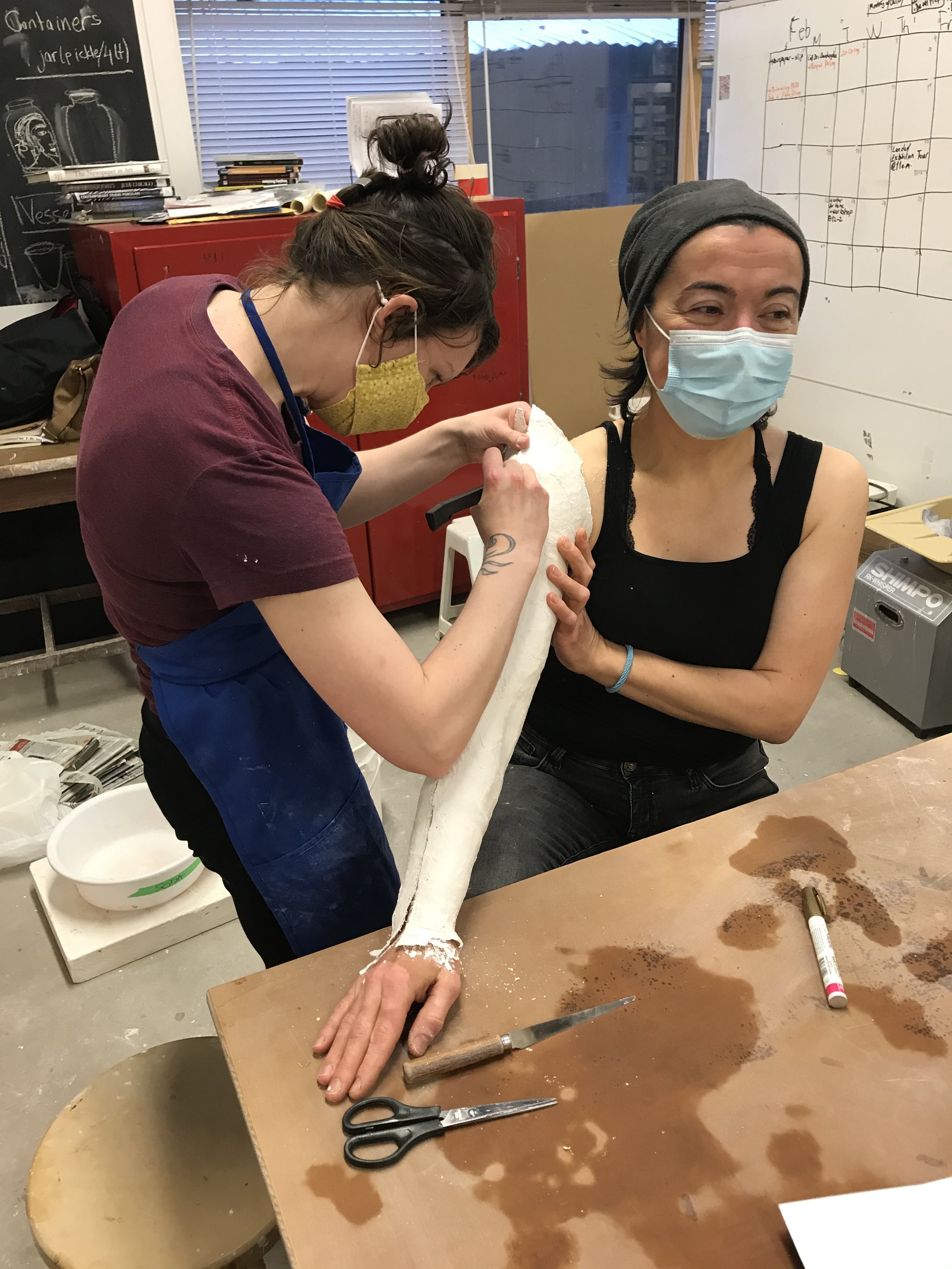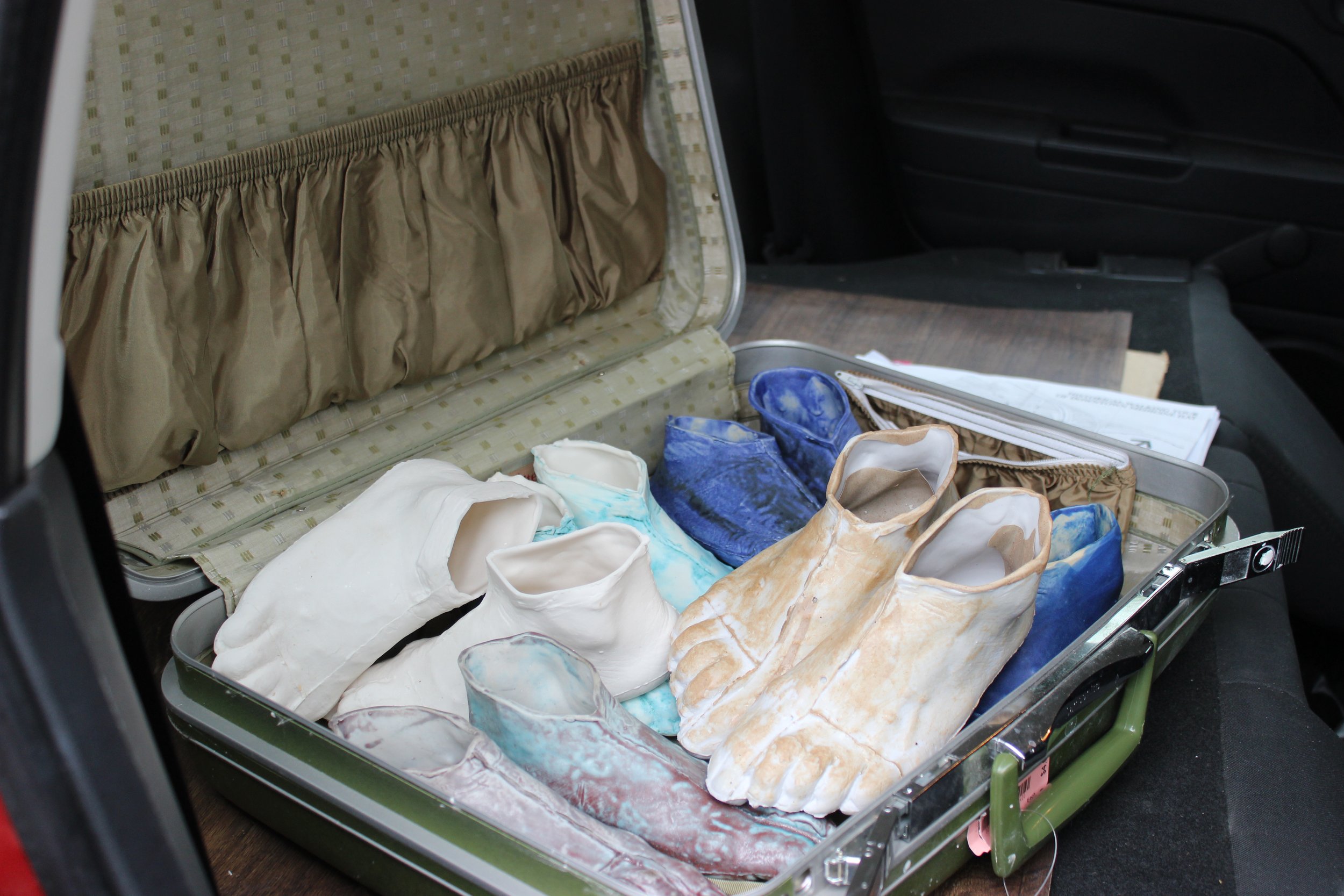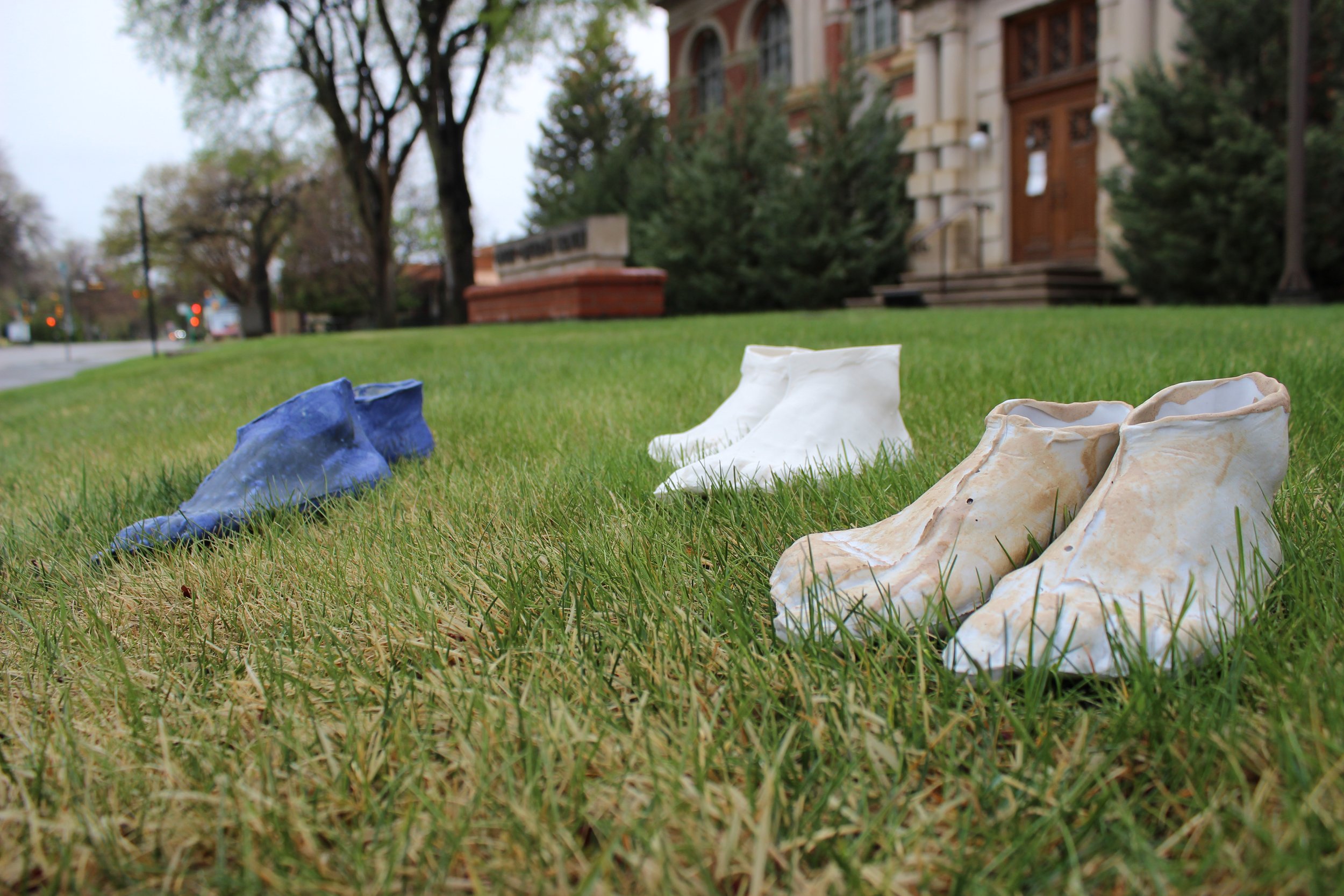Interview with Nurgül Rodriguez Part One
Nurgül Rodriguez, His·to·ry on strange soil, 2021. Porcelain, photography, public intervention / performance, Provincial Courthouse, Stop 2, Historical Walking Tour: Downtown Medicine Hat. Courtesy of the artist.
This is Part One of a three-part interview by Alana Bartol. View more images of His·to·ry on strange soil by Nurgül Rodriguez here.
Alana: We’ve had many conversations over the past year while you have been creating several bodies of work speaking to relationships with land, belonging, and displacement. It’s inspiring to see how prolific you have been. Much of your work was created through an artist residency at Medalta in Medicine Hat, Alberta. How has spending time at the Medalta Artist Residency and in Medicine Hat has impacted your work?
Nurgül: I applied for a 2-month residency at Medalta through a Calgary Arts Development Grant, but the residency took 4 months. I had one month in advance to prepare in 2020. Everything switched with the pandemic schedule, the second wave, and then later when I was leaving the third wave was coming on.
The plan was to work with my own body and then to break some walls, conceptually. I am a Middle Eastern woman, an immigrant woman, working with my body. Bringing my body to the work can bring up many things. For example, culturally, there are many boundaries in working with your own body. There are biases in understanding Middle Eastern women. So, I wanted to tear down some walls conceptually and I wanted to work with my body.
The pandemic was another thing that [brought up] my invisibility, visibility… everything was coming up at that time. It was like a surfacing of issues when people settled down and got scared. Everybody was dealing with the same conditions, protecting their own bodies. At that time, I said, okay, time to work with my own body. Time to bring in something that [is a] visibly tactile material, clay.
The material I like to work with as a clay body is porcelain. I want to make porcelain replicate my body. I was looking for another artist who could cast my body, but it didn’t happen. So, I tried to do other things because there was social distancing, and I didn’t know how to approach closeness, even with my closest people, so many things had to change. At that moment, I embraced it. I said, it’s ok.
At Medalta, I found an artist who could cast my body. I was teaching her – not teaching, training – on how I was doing it and then she was applying bandages on my body for casting. Casting is the process that made me find new connections and I think it is going to be lifelong. We just started a new collaboration project the other day. Carmen Belanger was stage manager for video documentation and another artist-in-residence, Yvonne Kustec, also helped me. Everybody became part of [the work] because I was approaching it like a workshop.
Collaboration through casting at Medalta. Courtesy of the artist.
A: So, it became collaborative.
N: Yes! Collaborative and no one asked for anything, it was coming naturally. Let’s do this. Let’s do that! It was like somebody organized everything and it happened.
A: I love that about artist residencies, when a community is created through people working together and figuring out how to support each other… you learn so much.
N: I was the only person who is a mom there. Mothering… it happened physically, bodily, everything I carry. I mean, we are mothers of the earth. Especially when you are an artist, you are a mother of everything… every piece created. I was also the oldest woman there, let’s say, wisest. [Laughter] It was wonderful. They were nourishing me; they were giving me support. There was lots of fear, lots of distance, but at the same time there was a lot of love we created while we were making. I was very happy extending my artist residency. Thank you for asking me that, I have to write my report at the end of the month, send in this grant report.
A: For the Remediation Room, you respond to a historical walking tour of downtown Medicine Hat (available on the Alberta Government website) that focuses on historic buildings in Medicine Hat’s old residential and commercial core. Most of the buildings were erected between 1909-1914 during the city’s first economic boom and include residences, institutions, and commercial buildings.
You created molds of your feet and from those, cast and fired seven pairs of feet in porcelain. The sculptures of the feet are brought to six stops on the historical walking tour and placed in front of or around the buildings. A series of photographs documents each site-responsive action or performance or maybe an intervention into the walk? Maybe that’s something we could talk about.
Some of the sculptures are white, identifiably porcelain, while others are glazed with various shades of blues and/or a clay-like brown. There are visible seams along the feet, we can see that they were constructed and remain unrefined.
Porcelain is an important material in your work. The way that you work with glazes, and the intentional imperfections of the forms trouble the notions of purity and refinement that porcelain is often associated with. Can you talk about your relationship with porcelain and why you use it in your work?
N: Thank you. I appreciate reflecting through your words on the physical qualities of the work. I was trying to do something, and it is being received. I appreciate that, especially the comment on the visible seams. I need to close the window, sorry.
[Leaves. Returns.]
Some windows, they vacuum the sound.
Let me start with how many pairs. For this series, there were seven pairs. I am number seven in the house. I wanted [the number] to be meaningful. My intention was to make 11 or 12 pairs, but I said, it’s good! Not too much, not crowded. It’s like my house, now with four or five people we are crowded. Especially with the pandemic...crowdedness has changed. Also, I can carry [the feet] with me wherever I go. I found the luggage at a thrift store...it’s so strong. I am thinking of using it the next time I travel.
Nurgül Rodriguez, His·to·ry on strange soil, 2021. Porcelain, glaze, suitcase. Courtesy of the artist.
Porcelain is a very old material. Porcelain is an innovation, kind of a developed clay body, that is manmade. It was developed and used for thousands of years in China before it got to Europe. The makers of porcelain used to bring up clay reserves and then leave it outside for 50 years, and under ultraviolet light it was refined. Potters were holding clay and digging clay for the next generation.
It is so interesting and attractive because from this side of the world, North America, porcelain has a very colonial voice. When I look at Rebecca Belmore’s work Rising to the Occasion (1987), she made a dress [that incorporated] porcelain teacup saucers. When I go to garage sales here, I buy different kinds of porcelain. The cups, the plates, and you can find a lot. So, in my research, I decided to work with porcelain but it was very difficult. As an immigrant, coming here, setting up in my house... you cannot work with clay in your home, you know, it’s so impossible.
Nurgül Rodriguez, His·to·ry on strange soil, 2021. Porcelain, glaze, suitcase. Courtesy of the artist.
So, when I got into the MFA program, I wanted to combine print and ceramic clay and later in my final MFA exhibition, I got there. I wasn’t just going there but all my subjects were taking me to how to be a good citizen in North America as an outsider. Unfortunately, it is happening, practicing otherness, in the academy, out of the academy...it doesn’t matter. I find myself all the time an insider and outsider: when I am in a multicultural environment, I am an insider, when I am with my son, if I go to family meetings or some other parental activities, I am an outsider. It was all these weird things I was experiencing.
One day I read in the newspaper, Mayor Nenshi was explaining why he didn’t go to Pride because there was alcohol. [The press] was bringing up his religion. And I read that he said, I am ok with any question, my skin got thicker now. I said, it shouldn’t be that way. The complexity of living in diversity made me think about the glaze.
In my work, there wasn’t that much glaze work. So, then being in Medalta and experiencing different kinds of firing, it made me think about that also. Those techniques, and then my experience, and then being in Medalta, I said, let’s combine them together. Each pair has its own history in making and has its own stories, why one is blue, why one is just slip, beige, why one is white, just pure porcelain. All of them are the same clay body but they have different glazes, like us.
The creation of porcelain in Europe is another important story. In the early 18th century, the first porcelain was made in Meissen (Germany). It is an interesting story, but we can go into that history later.
So, all of these things made me so interested [in porcelain] and are related to my process. Porcelain, as an object, is everywhere. It’s like a memory keeper. I always say to my students, this material is a memory keeper. In creating His·to·ry on strange soil, when I am there on the land, with the feet, the material, I feel like I am raising the history and thinking about memory differently.
My experience as a new settler, when I step on this land, I am pursuing many things in a wrong way because I am getting second-hand stories, which is colonialism. So then, I made the feet hollow, and I wanted to keep the seams. Whatever it [the place, the material] is giving I am taking. I am developing on knowledge at the same time there’s resistance.
Nurgül Rodriguez, His·to·ry on strange soil, 2021. Porcelain, photography, public intervention / performance, Provincial Courthouse, Stop 2, Historical Walking Tour: Downtown Medicine Hat. Courtesy of the artist.
A: The sculptures of the feet are hollow, as if the viewer is invited to step into them or to imagine the people that are absent or present at these sites.
Often positioned in pairs, the feet suggest groups of individuals walking or standing on the grounds of the buildings. The feet direct our attention to pathways, ground, and land they are placed on.
The feet appear to be aware of their relationship to each other and to the site, gathering in conversation with one another under benches and windows, in circles on manicured lawns, or standing together in a row to face an imposing wall. We also see them piled on top of each other, each form holding the others in balance.
I was thinking a lot about relationality between the pairs of feet, between you and the feet, and the feet and the sites.
N: Yes, I have been invited to another project in Calgary, maybe you heard about it, it is called “Bringing Power to Truth”, a new project. It has three spirals or groups: Indigenous people in one group, and then Black people in one group, and then People of Colour, I am in that spiral. I found myself in another group called Citizen Artists YYC. Our conversation became kind of [like] group activities: activism, storytelling, and artmaking. It is awesome and we are going to get together with other people and think about how we are going to learn about the land but there is one reality that we cannot deny, there is racism everywhere. There is racism in Calgary, unfortunately. We need to practice, not just understand, anti-racism, but people don’t know how to do that, so we are going to learn together.
When I read this question, I think about how we need to understand what empathy is. At the same time, we can’t see empathy as a sole solution and we need to practice empathy, not just understand it.
When I was learning a language, I knew that comprehending is different from understanding. Understanding means you can learn and start teaching something well, this is understanding. When I was becoming a Canadian citizen and studying the study guide, I was understanding on a certain level naturalization, becoming a Canadian citizen. You pledge to the royal monarchy, you see the history, you learn about the Treaty map, you learn about the language map, you learn about “official” things and you say, “Wait a minute, there are many things that are wrong here”. You already know that, while you are living here, but, you have one target on the wall, that you want to be a Canadian citizen and pass the borders. You want to have comfort, but you have to have discomfort also. This land has its own history. So, feeling empathy, understanding empathy, or experiencing inclusion are different.
Nurgül Rodriguez, His·to·ry on strange soil, 2021. Porcelain, photography, public intervention / performance, Provincial Courthouse, Stop 2, Historical Walking Tour: Downtown Medicine Hat. Photo: Carmen Belanger. Courtesy of the artist.
Through the sculptures of feet, I was thinking about suffering, well, not suffering, but how many struggles are at borders, and inside [us] there are different borders. Invisible borders. They are called boundaries, biases, situated knowledges. So, then you start dealing with the internal aspects. One thing, if you become a newcomer, especially a visible minority, you cannot be a fighter. You shouldn’t be a fighter because you promised the country that you are going to be a good citizen, so you start questioning. If you become a newcomer, especially if you are a visible minority, you promised the country that you are going to be a good citizen, so you start questioning and I see this in myself and in others: “whose land is this?” “Whose land?” So that brings complexity in my work. The most important thing is how to start, how to learn and where to start. As an artist, this is my role, that I have to learn and teach myself how to understand.
This is Part One of a three part interview. View more images of His·to·ry on strange soil by Nurgül Rodriguez here.





